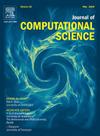Comparative evaluation of sparse and minimal data point cloud registration: A study on Tibiofemoral Bones
IF 3.1
3区 计算机科学
Q2 COMPUTER SCIENCE, INTERDISCIPLINARY APPLICATIONS
引用次数: 0
Abstract
An accurate bone registration is a crucial step in Computer-assisted Orthopaedic Surgery (CAOS) to estimate the relationship between a preoperative patient’s bone model and the actual position during surgery. A-mode ultrasound and motion capture system is a new promising non-invasive technique to determine the bone’s 3D pose. The main challenge with such a system is the sparsity of the measurement; it could trap the optimization, which minimizes the registration error, in the local minima. In this paper, we aim to find the registration algorithm that could provide enough surgical navigation accuracy. Several registration algorithms were compared using Monte Carlo simulations. The number of points and placement sensitivity were also investigated while keeping the practical aspect of the system. With 15 points, Unscented Kalman Filter (UKF)-based registration with 6D similarity vector showed superior to the other examined algorithms in minimizing the transformation error. In terms of balancing the accuracy and the equipment availability, the simulation showed that points needed to be dispersedly placed; 15 points were sufficient to register the femur, but 20 points were required to register the tibia. Beyond this number, the registration error hardly improved and will therefore be used to base our number of sensors on.
稀疏和最小数据点云配准的比较评价:胫骨股骨的研究
准确的骨配准是计算机辅助骨科手术(CAOS)中评估术前患者骨模型与术中实际位置之间关系的关键步骤。a型超声和运动捕捉系统是一种很有前途的非侵入性骨三维姿态检测技术。这种系统的主要挑战是测量的稀疏性;它可以将最小化配准误差的优化捕获在局部最小值中。在本文中,我们的目标是找到能够提供足够的手术导航精度的配准算法。通过蒙特卡罗仿真对几种配准算法进行了比较。在保持系统实用性的前提下,还研究了点的数量和放置灵敏度。在15个点上,Unscented Kalman Filter (UKF)与6D相似向量的配准在最小化变换误差方面优于其他算法。在平衡精度和设备可用性方面,仿真结果表明,点需要分散放置;15个点足以固定股骨,但20个点才能固定胫骨。超过这个数字,注册误差几乎没有改善,因此将用于基于我们的传感器数量。
本文章由计算机程序翻译,如有差异,请以英文原文为准。
求助全文
约1分钟内获得全文
求助全文
来源期刊

Journal of Computational Science
COMPUTER SCIENCE, INTERDISCIPLINARY APPLICATIONS-COMPUTER SCIENCE, THEORY & METHODS
CiteScore
5.50
自引率
3.00%
发文量
227
审稿时长
41 days
期刊介绍:
Computational Science is a rapidly growing multi- and interdisciplinary field that uses advanced computing and data analysis to understand and solve complex problems. It has reached a level of predictive capability that now firmly complements the traditional pillars of experimentation and theory.
The recent advances in experimental techniques such as detectors, on-line sensor networks and high-resolution imaging techniques, have opened up new windows into physical and biological processes at many levels of detail. The resulting data explosion allows for detailed data driven modeling and simulation.
This new discipline in science combines computational thinking, modern computational methods, devices and collateral technologies to address problems far beyond the scope of traditional numerical methods.
Computational science typically unifies three distinct elements:
• Modeling, Algorithms and Simulations (e.g. numerical and non-numerical, discrete and continuous);
• Software developed to solve science (e.g., biological, physical, and social), engineering, medicine, and humanities problems;
• Computer and information science that develops and optimizes the advanced system hardware, software, networking, and data management components (e.g. problem solving environments).
 求助内容:
求助内容: 应助结果提醒方式:
应助结果提醒方式:


